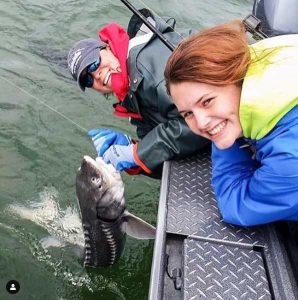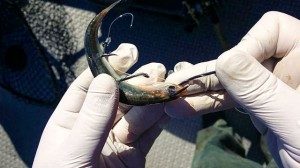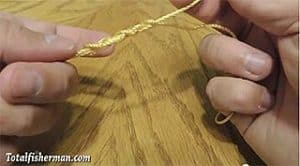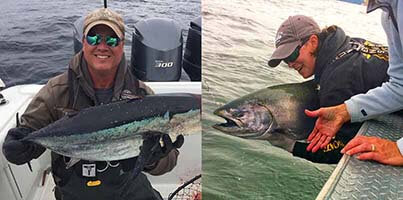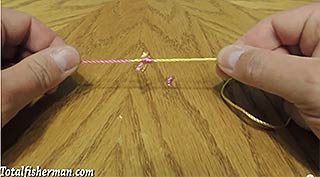
Most Popular
Posted on by kmnewell
Sturgeon Information and Facts
Posted on by kmnewell
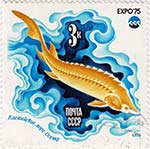
Tiger Fish
Posted on by kmnewell
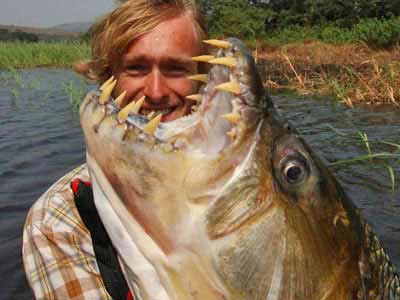
Alligator Gar
Posted on by kmnewell
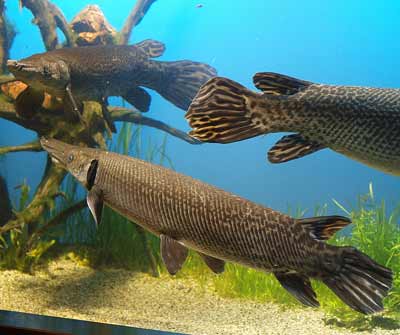
Mahi Mahi Fish, Fishing and Information
Posted on by kmnewell
Check out our Astoria Fishing Charters and Washington Halibut Charters
MAHI MAHI
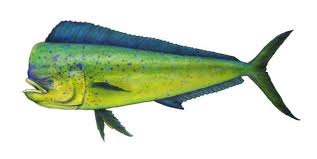
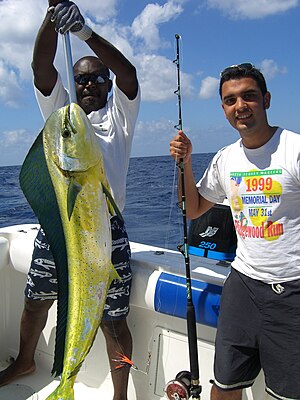
The Mahi-Mahi fish has several other names and is popularly known as – Mahi Mahi, Dorado and Common Dolphinfish.
The Coryphaenidae family is a two member family with the Coryphaena genus, under which the Common Dolphinfish and the Pompano Dolphinfish is classified. The Pompano Dolphinfish like the Mahi Mahi fish have compressed heads and long dorsal fins that extends nearly to the entire length of the body but are smaller in size therefore giving rise to occasions where it is mistaken for a younger Mahi Mahi fish.
Mahi Mahi are extremely agile acrobatic game fish that are found in warm tropical and subtropical waters of the world. These surface dwelling ray finned fish are know for their bright dazzling colors that are difficult to accurately describe because of the rapid color changes it undergoes when it get’s excited. This feature of the Mahi Mahi is what gave rise to its Spanish name, Dorado Maverikos, which literally translates to “Golden Maverick”.
Mahi Mahi is often assumed to be related to mammalian dolphins because of it being referred to as the Common Dolphin fish, however this is not true. The similarity between the two species ends with their name as they are very different both in terms of features and characteristics. Mahi Mahi is actually the Hawaiian name of the Dolphinfish and it means “very strong”. This name has been popularly adapted in many places in order to avoid this confusion.
The male fish of this species are known as bulls while the female fish are known as cows. It is quite easy to differentiate a male fish from the female fish. An identifying feature is the forehead. The forehead of the male fish is protruding and is prominent while the female fish has a rounded head.
The most attractive feature of Mahi Mahi fish is undoubtedly its stunning colors. The dorsal region of the Mahi Mahi is either in a rich iridescent blue or blue green color while the dorsal fin is in rich blue. It’s anal and caudal fin are golden in color while the Pectoral and Pelvic fins are golden yellow with blue edges. Its golden side is sprinkled with dark and light blue spots. The belly region is usually either silvery or yellowish. It is difficult to distinguish the colors once it’s brought out of the water as the color rapidly changes to yellowish grey upon its death. A Mahi Mahi fish with a grey skin is not fit for consumption as the color is an indication of it being spoiled.
Despite the steady increase in fishing pressures the Mahi Mahi population has remained healthy and stable because of it being prolific spawners. Mahi Mahi is one among the fastest growing fishes found in the world and is extremely migratory. They are carnivorous fish and feed on flying fish, crustaceans, squid, mackerel, and other small fish. They are particularly skilled in hunting flying fish. They are also known to feed on zooplankton.

Mahi Mahi is found in all the warm oceans of the world and its commercial value is increasing with time. Around 30,000 to 40,000 tons of Mahi Mahi is being harvested every year around the world with Ecuador, Costa Rica, Japan, and the United States being the largest exporting countries. It is primarily consumed in the United States, Caribbean countries, Japan and Europe.
These fish are one of the favorite saltwater species for sports fishermen. They are preferred over other game fishes because of their unique color and beauty. These fish “light up” when hooked and display hues of neon while trying to free themselves from the hook. Mahi are also available in abundance, which is another plus for fishermen and the fact that these fish are typically large makes the whole fishing experience exciting. Though these fishes on an average weigh 15 to 30 pounds, there have been cases where the fishes have weighed above 50 pounds however such catches are rare. Another reason for the sports fishermen going after Mahi Mahi is because of its fighting spirit. They tend to put up a long fight.
Mahi Mahi have a peculiar habit of being present around marine debris such as palm trees, floating boards or even something as small as a soda can and Sargasso weed lines. An experienced fisherman is able to identify the fish species present near the debris or the Sargasso weed by observing the Frigate birds behavior.

The Frigate bird dives down for small fish that congregate near the debris and hence the Frigate Birds presence can also be used as a strong indicator of the presence of Mahi which also like to eat the same bait fish.
Trolling is the most popular method practiced for catching a Dolphin fish. In this method one or more fishing lines with lures or bait fish are attached to the back of the fishing boat or are slowly released into the water, if not in motion, to catch the fish. Ballyhoo is the commonly used bait fish.
Mahi Mahi exhibit schooling behavior wherein the fish swim in groups in a coordinated manner, in the same direction, in order to form a defense against predators as well as to increase the school’s hunting success. Thus, when a school of Mahi Mahi is encountered, the fish that is caught is often not removed from the water but rather is left swimming near the boat so that the other fish stay close by and can then be hopefully caught. These fishes are then caught using techniques like fly casting.
An interesting technique used in Hawaii involves using kites. The offshore kite fishing technique is a kind of sports fishing method where live baits are used to attract surface dwelling fish such as the Dolphin. This technique is advantageous as it gives access to areas that might not be easy to navigate in boats. In Hawaii this technique has been adopted to catch a variety of fish from ocean side cliffs.
Recreational fishing of Mahi Mahi around North America is predominant along the Pacific Coast, more so in the Gulf of California, off the coast of Costa Rica and offshore in the Atlantic Ocean from New Jersey to Florida. Some of the ideal spots for recreational fishing of Mahi Mahi are Hawaii, Southeast Asia, Gulf of Mexico, Pacific coast of the Caribbean Sea and Costa Rica.
How To Fillet A Sturgeon
Posted on by kmnewell
Check out our Astoria Fishing Charters and Washington Halibut Charters
Filleting sturgeon is definitely not as easy as filleting salmon but once you watch this video you’re going to be well on you’re way to becoming a pro!
If you’re interested in purchasing the same high quality knives used in the video, scroll down and visit our affiliate partners.
It’s important to have sharp knifes and to keep them sharp when you’re filleting fish of this size. Having the correct knife for each task keeps the knives sharper longer and makes processing the fish faster because you have the correct tools for the job!
The 12″ Slicing Knife is what we used to take the skin off of the meat.
The 8″ Wavy Edge Bread Knife is what was used to remove the diamonds/spikes from the outside of the fish.
The 10″ Butcher Knife was used for miscellaneous duty throughout the video.
The 9″ flexible fillet knife is what was used for removing the ribs and trim work.
The Victorinox/Forschner honing steel you see in the video is the best money can buy, you will be amazed at the edge this steel can put on a knife and keep on a knife. If your knives are very dull you may even consider buying a diamond steel for heavy duty sharpening and then the honing steel for getting and maintaining that razors edge.
Learning how to fillet a large sturgeon like a pro takes quite a bit of practice but if you follow these steps and take your time you will find that the end result is a great looking fillet with little to no waste.
Andy: The first thing that we’re going to do is remove the scutes on the sides and on the back. We cut them off the back because it actually exposes the line that you cut down and this last one on the head is kind of tough to get off, you’re going to have to put a little pressure on it. Remove the fins so we don’t have to cut around them.
I’m putting quite a bit of pressure on this knife to get these diamonds off, but if you hold your knife flat you’re not going to cut into the fish. If you hold your knife flat, and scrape, they’ll come right off without cutting in.
Kevin: Andy, why do you cut the scutes off?
Andy: The reason you cut them off is because when you go to skin it, the scutes will actually push down into the meat when you lay the meat onto the table and then the knife will catch on every one as you’re skinning and you’ll end up cutting through the skin and that really puts an extra twist on your skinning.
So that’s how we prepare it.
I want to show you this line here that we’re going to cut down. Right here, you see this? Where you’ve got white then yellow then white, that’s the line we cut down and I start right here at the dorsal fin, and I’m only going to in about a quarter of an inch just to get my cut started and I’m going to cut down both sides on that line. And again, just going about a quarter of an inch. Then I’m going to come back through and I’m straight down with the knife, perfectly straight down and absolutely straight.
Once you get down there about half an inch you can actually angle that knife a little bit against that center to make sure that you keep going straight down.
And eventually what you do is you start hitting the top of the ribs. You can feel the knife going “tap tap” on the top of the ribs on both sides.
If you open that up you can actually see that the ribs start to go out. So you get it to that point and then with just a little extra pressure you go right through the ribcage on each side and you end up like this when you’re opening this thing up and you’ve separated the ribs on both sides.
At this point I turn it over, cut around the gill plate, poke my knife through and come right down to the tail and cut that off. Going through the ribs, it lays open like that. Then you come back through with the knife and just cut through that little stomach liner.If you hold this thing up to the light you can actually see the white line there, that’s the very dead center of the belly and it’s paper thin and that will just cut right off like that and there’s your one side.
When you flip it over this side is already started, there’s no guess work or flopping around. This is actually completely separated here, you just put your knife in and go right down the back there. You flip that side over then again just cut through that stomach liner and your fillet is off. You didn’t cut the head off, you didn’t have to gut it, everything (head, guts, backbone, etc) is still intact.
Rinse the table.
Ok, so then you flip this thing over and right where the fin is there, where the anal is, you just cut that off and you cut right down the edge of those diamonds and you cut that little belly strip off. There’s nothing there. By the time you skin each side you’re not wasting any meat, there’s just nothing there to save. The same thing here you just cut right down that diamond line, right past that fin and get rid of all that.
To skin it, we’re just going to go through it here like you would any other fish and remove the skin. Now there’s some tricks to it. You want to put some pressure on this. I’m pulling on this tail and I’m putting a lot of pressure on it. Almost as much pressure pulling on the skin as pushing on the knife and just kind of walk it through and it’ll come right off of there.
The way I like to do it is I leave the ribcage on this side because it supports this meat while you’re trimming the red meat. If you cut the ribs off first, this will concave and it makes it very hard to trim off.
What I’m going to do is pull on this, kind of straighten it out, but putting a little pressure on there. I’m using a very flexible knife that bends and where this bends at the bottom of the curve is where it’s going to cut and I’m going to push down on it. Again I’m going to keep the knife very flat. If you get it at an angle you’re going to cut into the meat and if you get it up you’re going to pop it up though, but if you keep it very flat and just give it little tiny see saw action and then control where the deepest part of the bend is, then you can walk that knife right down it and take that whole thing off, that little paper thin strip and it just goes from red to white on a paper thin strip. And I’m going to follow that edge and I’m just going to keep cutting down.
Kevin: Andy, why do you take the fat off?
Andy: The fat has a very strong fishy taste to it and it’s just overpowering and will just make it taste fishy. If you get this red off, and you don’t have to get every tiny speck off, but if you get the bulk of it off it improves the quality of the fish a 1000 times.
Then I also cut from the tail to the head. There is a bit of a grain to this meat and it seems to come off smoother and nicer if you’re going from tail to head, but the last little bit of the tail here, you have to spin it around and get that stuff. The hardest part is the tip of the tail, that red kind of ingrains pretty deep in there.
Now, we’re going to wedge this center line out and I’m going to keep my knife flat. You’re not going to cut into it like this because you’ll cut into it too deep. My handle is actually going to ride against the skin and I’m going to cut in there at about a 45 and I’m just going to walk it right down like that and I’m going to turn it over on this side and do the same thing.
And then sometimes you’ve got to cut through there a second time and then you wedge that out. You don’t want to cut too deep, you can always go back through and hit it a second time if you don’t cut deep enough but you don’t want to cut too deep on your first pass and end up wasting a lot of your good quality meat. So at this point I’m going to flip it over and take these ribs off. I’m going to switch places because I can only cut one way.
Again, the knife can only cut one way. I’m going the lay knife as flat as I can and I’m just going catch right under the rib and just pull it along the rib and just make a couple of lengthy cuts down here, and I’m actually putting a lot of pressure on that knife and the more pressure I put on it the shallower it cuts. If you don’t put enough pressure it it’ll either walk into the meat or pop up through, but the more pressure you put on it, it’ll actually stay flat. And that’s the ribs and then again the same thing here – I’m just going to walk that down and trim that off.
If it’s red, this is the front shoulder where that main pectoral fin is and you want to cut that little chunk of red off. Trim up any bits of remaining stomach liners. This is the fletching of off the dorsal fine but you end up with a nice fillet here.
If you want to hit any last little spots like you’ve got a little spot like this, the trick is to make that spot the highest spot so I’m going to put the fish in my hand and I’m going to curl it up and make that spot high and then I’m just going to shave that right of without gauging or taking anything off. I’m going to raise that, make that the highest spot in the meat and just peel it just like you’re peeling a potato.
That’s a pretty clean piece of meat and that’s how you fillet a sturgeon.
Learn the #1 secret to catching more fish!
Posted on by kmnewell
Check out our Astoria Fishing Charters and Washington Halibut Charters
Photo courtesy of Langara Fishing Adventures & Flickr
There’s an old saying that goes like this, “The guy that works the hardest gets the most stuff!” Fishing is no different! The harder you work, the more time you spend on the water, then the more knowledge you’re going to gain; and you’re going to put more fish in the box because of it!
The number one secret to catching more fish is this … work harder.
When I talk about working harder at fishing, it’s not always intuitive what this means, but let me give you some ideas.
Get to the dock earlier.
Leave the dock later.
Work your rod like a maniac, keeping it in the zone and fishing effectively. Make fishing the primary priority and relaxing secondary.
Keep your bait fresh by changing it way more often than you think you should.
Talk to other fishermen.
Fish more days out of the year.
Fish with new people.
Fish with fishing guides.
Study the charts.
Know the tide table.
Try new things, be willing to change.
Try old things again, be willing to change but don’t forget the things that have worked before.
Take note of changing patterns from year to year and from day to day.
Stay focused and driven, but remember it’s supposed to be fun.
Working harder gets increased results. Some folks like to talk about working smarter as well. Some folks have the ability to work smarter and some don’t. I have known a lot of folks over the years that are lacking in the smarts department but still hands down out produce the geniuses because they are just willing to put in more effort day in and day out.
Working hard isn’t always fun and working hard is almost never easy, but if you want to catch more fish and have more success then there is definitely a way to make it happen. Start today, make it a habit and a lifestyle, and the next thing you know it’s no longer work it’s just the way you are.
